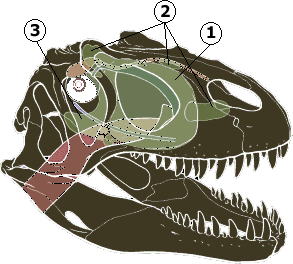Craniofacial Air Sinuses
Homepage > Dinosaur Anatomy - Craniofacial
Air Sinuses
A complicated anatomical system pervaded in the heads of dinosaurs, it was composed of air filled sinuses. Pneumatization is the process in which epithelial outgrowths extend and invade the surrounding bones producing cavities within these bones. The result of forming these air filled bones is known as pneumaticity. Many dinosaurs are known to be animals containing these complex anatomical features.
 Paranasal
pneumaticity in theropod dinosaurs. To the left a skull of Allosaurus
fragilis showing the antorbital paranasal air sinus and some of its epithelial
diverticula.
Paranasal
pneumaticity in theropod dinosaurs. To the left a skull of Allosaurus
fragilis showing the antorbital paranasal air sinus and some of its epithelial
diverticula.
1.- Sinus antorbitalis in antorbital cavity.
2.- Subsidiary diverticula in accessory cavities.
3.- Suborbital diverticulum.
The two major pneumatic systems in dinosaurs include outgrowths of the nasal cavity and the second being outgrowths of the tympanic (middle ear) cavity.The main paranasal air sinus is known as the antorbital sinus, its structure is composed of an outgrowth of the main nasal cavity. The antorbital sinus produces large lateral face cavities, which are known as the antorbital cavity and antorbital fenestra. In addition to the antorbital sinus, some dinosaurs are known to have air sacs deriving from a different section of the nasal cavity, such as the nasal vestibule. Such vestibule tends to pneumatize bones surrounding the bony nostril.
Paratympanic air sinuses are less common in archosaurs, but are best developed in theropod dinosaurs. In addition to the paranasal and the paratympanic sinuses, there are other sinus systems more poorly known, such sinuses include diverticula from the cervical system, the median pharyngeal system which extends as an outgrowth from the throat invading the base of the skull (basisphenoid and basioccipital bones). It has been suggested that the median pharyngeal pneumatic system is created secondary to the aeration of the embryonic hypophysial pouch (of Rathke).
Functions of Sinuses
Several ideas have been proposed over the years, including sinuses acting
as shock absorbers, voice resonators, thermal isolators, weight reducing
hollow spaces, and many more. Some of these ideas might sound irrational,
but some fit the function of very specific animals. Such as the crests
of hadrosaurids functioning as resonating chambers. However, these functions
cannot be applied in general to every animal that possesses the sinus.
Sinuses should not be considered as empty spaces either. The majority of sinuses are lined by a thin epithelial membrane, creating a balloon like structure. It is as if these membranes expand as much as possible pneumatizing its surrounding bone, but at the same time this expansion is governed by the biomechanical forces applied to its structures. Such forces include powerful biting and chewing. The bone being responsive to this local stress would generate new, denser bone to create a more powerful structure, able to adapt to these stress factors.